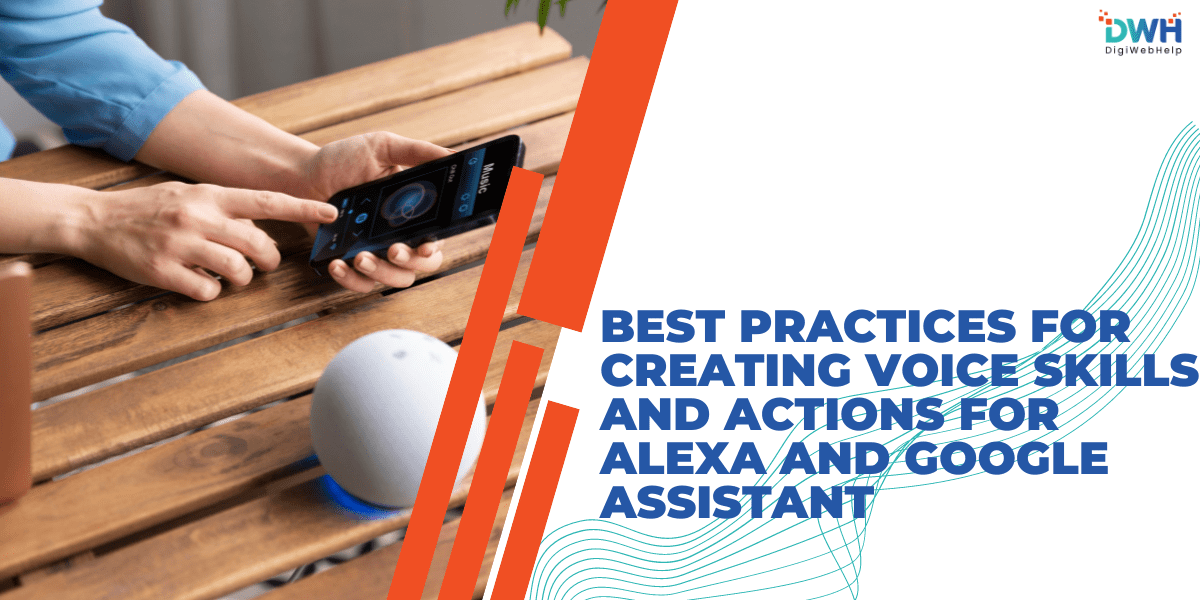
Best Practices for Creating Voice Skills and Actions for Alexa and Google Assistant
Over the past few years, there has been a revolutionary shift towards voice-enabled conversational interfaces. From Google Home to Amazon Alexa, voice technology has transformed how people interact with their devices. These AI-powered assistants have become an integral part of daily life, allowing users to control smart home devices, set reminders, and access information with simple voice commands.
This opens up a world of opportunities for businesses and developers to create engaging and functional voice applications, known as “skills” for Alexa and “actions” for Google Assistant. In this blog, we’ll explore the best practices for creating voice skills and actions that offer seamless, user-friendly experiences on these platforms.
Understanding Voice Skills and Actions
Voice assistants like Alexa and Google Assistant rely on voice skills and actions to perform tasks. In Alexa, these tasks are called “skills.” For Google Assistant, they are referred to as “actions.” Essentially, they’re voice-driven apps that extend the functionality of these platforms. This allows users to interact with third-party services or control devices via commands.
- Alexa Skills: Alexa skills applications are designed to enhance Alexa’s abilities. These skills enable users to interact with devices, make purchases, or get information on various topics.
- Google Assistant Actions: Actions serve the same purpose within Google’s ecosystem. They allow voice-based interactions possible across Google’s services and other connected applications.
For businesses and developers, investing in voice skills or actions offers a unique opportunity to connect with customers directly. Whether enhancing customer service or offering hands-free experiences, voice apps add innovative touchpoints for user engagement.
Key Considerations Before Building Voice Skills and Actions
Before jumping into Google Actions and Alexa skills development, it is essential to plan carefully. User needs are the heart of a successful voice app. The key considerations for developing successful voice skills and actions:
- Identifying Target Audience: Understanding your audience is crucial. Who are they? What are their daily routines? Understanding user persona helps create more relevant and engaging voice interactions.
- Use Case Mapping: Identifying specific problems your skill and action will solve is important. Will it be an entertainment app, a productivity tool, or something else? Mapping out clear use cases ensures your voice app is useful.
- Market Research: Analyzing existing voice apps can offer insights into what works and what doesn’t. Study popular skills and actions, particularly in your niche, to understand what drives their success.
Best Practices for Designing User-Friendly Voice Interactions
Creating a smooth and natural interaction is the key to building successful voice skills or actions. Here are a few best practices to follow for your voice app design:
- Simplified Voice Commands: Voice interactions should be simple and intuitive. Users may not be able to remember complicated commands, so keep instructions clear and direct.
- Natural Language Processing: Use NLP to help voice apps understand user inputs accurately. People use more conversational language when communicating via voice than text.
- Conversational Design: Design interactions that mimic human conversation. Responses should be smooth and not feel robotic. A human-like conversation will enhance engagement and user satisfaction.
- Error Handling: Misunderstandings are inevitable. Ensure your voice app can smoothly manage errors or unclear voice commands, offering helpful prompts for users to try again.
Optimize for Voice Search
Voice search is an essential tool in how voice assistants function. Users frequently rely on these assistants for quick responses, and optimizing for voice search ensures your voice skill and command are more discoverable.
- Using Keywords: Research the kinds of words and phrases users commonly employ in voice searches. Voice queries are usually longer and more conversational than text searches.
- Concise Response: Voice search results should be short and to the point. Don’t wear out your listeners with long-winded answers. Keep your responses brief yet informative.
Testing and Iteration
Creating voice skills or actions is an interactive process that involves testing and refining to improve interactions.
- Beta Testing: Involve a select group of users to test your voice app and gather valuable feedback. This can help identify areas where users may struggle or lose interest.
- Refining Interactions: Use beta testing feedback to improve your voice skills or actions. Sometimes, users may find some commands confusing or struggle with a specific app feature.
- Continuous Updates: As user needs evolve, so must your voice skill or action. Keep track feedback and analytics to identify a need for new features and improve your app regularly.
Focus on Accessibility
AI voice assistants present a significant opportunity to enhance accessibility, especially for those with disabilities.
- Clear Language: Your voice application should use simple and easy-to-understand language. Avoid jargon or overly complex terms that can confuse users.
- Multi-Language Support: Offering interactions in multiple languages can significantly broaden your voice app’s reach, allowing more people to benefit from it.
Integration with Other Devices
Voice assistants are often at the center of a broader ecosystem of smart devices, from smart home automation systems to wearable technology.
- Smart Home Integration: Alexa and Google Assistant can control different smart home devices, such as lights, thermostats, door locks, security cameras, smart speakers, window blinds, and displays. This integration makes the smart home experience more efficient and personalized.
- Cross-Platform Experience: For a truly seamless experience, make sure that your voice skill or action works across different platforms and devices. This will let users switch around more easily.
Security and Privacy Considerations
With growing privacy and data security concerns in voice-enabled applications, it is essential to prioritize robust security measures when creating voice skills and commands.
- Data Privacy: Be clear to users about what data you will collect and how it will be used. Being transparent about your privacy policies builds trust.
- Robust Security: Implement advanced security features to protect sensitive information. This includes encryption and secure handling of user data.
Conclusion
To create successful voice skills and actions, it’s crucial to focus on intuitive design, user engagement, and seamless functionality. By adhering to best practices like simplifying commands, leveraging natural language processing, and optimizing for voice search, you can deliver a standout experience. As voice technology evolves, staying adaptable and consistently improving your Alexa Skills and Google Actions will ensure they remain relevant and valuable to users over time.
Ready to bring your brand to life through conversational interfaces? Let our expert team help you with tailored voice app design solutions that engage users and enhance customer experiences across Alexa and Google Assistant platforms.










